Research on Data Mining of Permission-Induced Risk for Android IoT Devices
Abstract
1. Introduction
- We develop a permission-based feature selection approach using (1) Permission Ranking, (2) similarity-based permission feature selection, for the identification of an essential subset of permissions.
- We also evaluate the effectiveness of the mined association rules for the permission-based which improves the accuracy of prediction.
- Finally, we enhance the performance of random forest algorithm by iteratively remove the unnecessary features and setting the upper limit on the number of trees in the random forest to improve the accuracy and recall rate, which leads to a secure data exchange between IoT devices and Android devices.
2. Literature Review
2.1. Static Analysis
2.1.1. Permission-Based Analysis
2.1.2. Suspicious API Calls
2.2. Dynamic Analysis
2.3. Hybrid Analysis
2.4. A Comparison of Static, Dynamic, and Hybrid Analysis
- Single Category features: The advantages of single category features are easy to extract, and low power computation. The limitations associated with this method are code obstruction, imitation attack and low precision.
- Multiple categories of Features: The advantages of multiple category features are easy to extract, and high accuracy. The limitations associated with this method are Mimicry attack, high computation, code obfuscation, and difficult to handle multiple features
- Single Category features: it poses a better accuracy and it is easy to recover code obfuscation as compared with static analysis. However, its feature extraction process is difficult, and it consumes high resources.
- Multiple categories of Features: It gives better accuracy and it is easy to recover code obfuscation as compared with a static and dynamic single category. The limitations of this approach are: (1) difficult to handle multiple features; (2) high resources; and (3) more time needed for computation.
3. Proposed Scheme and Methodology
3.1. Permission Ranking
3.2. Similarity-Based Permission Feature Selection
3.3. Association Rule Mining Algorithm Based on Probabilistic Model
- STEP1:
- Find out the frequent two-permissions sets
- STEP2:
- Diversity-based interestingness measures for association rule using frequent two itemsets that was developed by Piatetsky-Shapiro [53]
- -
- When support , the two-item sets are mutually independent. That is, the association rule is uninteresting.
- -
- if interest , Y and Z are correlated positively.
- -
- if interest , Y and Z are commonly independent, and the common two-item sets should be rejected.
- -
- if interest , Y and Z are negatively correlated.
- STEP3:
- Create the association rule based on the permission shown in Algorthim 1
- STEP4:
- Calculate probability table of the association rules.
| Algorithm 1 Association Rule set R For Permission Based |
| 1: Associaion Rule Set R 2: minimum thershold of support cofficient 3: minimum thershold of confidence cofficient 4: for Z=D do 5: 6: 7: for Y in D do 8: if L2 and and then 9: 10: end if 11: 12: end for 13: end for 14: Association Rule R |
3.4. Improved Random Forest Classifier
| Algorithm 2 Modified Random Forest (IRF) |
| 1: Grow inital forest and random tress and feature vector 2: An average ranking calculated weight ranked the all features 3: Features from the ranked list, place the top = in 4: Put rest = # features in 5: n is the number of pass. Initialize 6: for do 7: compute mean and standard deviation of features weights in 8: Find , if no such j exist 9: get rid of unimportant features, find the most informative feature set whose weight greater than the minimum value of the important features weight. so = : , 10: Find 11: Find and 12: and . Calculate and 13: Find ; 14: Grow forest and tress and feature vector 15: Calculate Weights and ranked the all features 16: 17: end for |
4. Experimentation and Results
4.1. DATASET
4.2. Ranking and Similarity Based Frequency of the Permissions
4.3. Association Rule Mining Algorithm Based Feature Selection
4.4. Machine Learning Malware Detection
4.5. Compared with Other Methods
5. Conclusions
Author Contributions
Acknowledgments
Conflicts of Interest
References
- Park, J.S.; Youn, T.Y.; Kim, H.B.; Rhee, K.H.; Shin, S.U. Smart contract-based review system for an IoT data marketplace. Sensors 2018, 18, 3577. [Google Scholar] [CrossRef] [PubMed]
- Risteska Stojkoska, B.L.; Trivodaliev, K.V. A review of Internet of Things for smart home: Challenges and solutions. J. Clean. Prod. 2017, 140, 1454–1464. [Google Scholar] [CrossRef]
- Damshenas, M.; Dehghantanha, A.; Choo, K.K.R.; Mahmud, R. M0Droid: An Android Behavioral-Based Malware Detection Model. J. Inf. Priv. Secur. 2015, 11, 141–157. [Google Scholar] [CrossRef]
- Walls, J.; Choo, K.K.R. A review of free cloud-based anti-malware apps for android. In Proceedings of the 14th IEEE International Conference on Trust, Security and Privacy in Computing and Communications, Helsinki, Finland, 20–22 August 2015; Volume 1, pp. 1053–1058. [Google Scholar] [CrossRef]
- Chen, H.; Su, J.; Qiao, L.; Xin, Q.; Chen, H.; Su, J.; Qiao, L.; Xin, Q. Malware Collusion Attack against SVM: Issues and Countermeasures. Appl. Sci. 2018, 8, 1718. [Google Scholar] [CrossRef]
- Dogru, B.; Kiraz, O. Web-Based Android Malicious Software Detection and Classification System. Appl. Sci. 2018, 8, 1622. [Google Scholar] [CrossRef]
- Sui, L. Strategy Analytics: Android captures record 88 percent share of global smartphone shipments in Q3 2016. Strateg. Anal. Res. Experts Anal. 2016, 28, 28–35. [Google Scholar]
- Demontis, A.; Melis, M.; Biggio, B.; Maiorca, D.; Arp, D.; Rieck, K.; Corona, I.; Giacinto, G.; Roli, F. Yes, Machine Learning Can Be More Secure! A Case Study on Android Malware Detection. IEEE Trans. Dependable Secur. Comput. 2017, 5971. [Google Scholar] [CrossRef]
- Yerima, S.Y.; Sezer, S.; Muttik, I. Android malware detection using parallel machine learning classifiers. In Proceedings of the 2014 8th International Conference on Next Generation Mobile Applications, Services and Technologies, NGMAST 2014, Oxford, UK, 10–12 September 2014. [Google Scholar] [CrossRef]
- Enck, W.; Gilbert, P.; Chun, B.G.; Cox, L.P.; Jung, J.; McDaniel, P.; Sheth, A.N. TaintDroid: An Information-Flow Tracking System for Realtime Privacy Monitoring on Smartphones. Commun. ACM 2014, 57, 99–106. [Google Scholar] [CrossRef]
- Canfora, G.; Mercaldo, F.; Visaggio, C. Mobile malware detection using op-code frequency histograms. In Proceedings of the SECRYPT 2015—12th International Conference on Security and Cryptography, Part of 12th International Joint Conference on e-Business and Telecommunications (ICETE 2015), Colmar, France, 20–22 July 2015. [Google Scholar] [CrossRef]
- Burguera, I.; Zurutuza, U.; Nadjm-Tehrani, S. Crowdroid: Behavior-Based Malware Detection System for Android. In Proceedings of the 1st ACM Workshop on Security and Privacy in Smartphones and Mobile Devices—SPSM ’11, Chicago, IL, USA, 17–21 October 2011; p. 15. [Google Scholar] [CrossRef]
- Kim, J.; Choi, H.; Namkung, H.; Choi, W.; Choi, B.; Hong, H.; Kim, Y.; Lee, J.; Han, D. Enabling Automatic Protocol Behavior Analysis for Android Applications. In Proceedings of the CoNEXT 2016—Proceedings of the 12th International Conference on Emerging Networking EXperiments and Technologies, Irvine, CA, USA, 12–15 December 2016; pp. 281–295. [Google Scholar] [CrossRef]
- Chan, P.P.; Song, W.K. Static detection of Android malware by using permissions and API calls. In Proceedings of the International Conference on Machine Learning and Cybernetics, Lanzhou, China, 13–16 July 2014; Volume 1, pp. 82–87. [Google Scholar] [CrossRef]
- Dini, G.; Martinelli, F.; Matteucci, I.; Petrocchi, M.; Saracino, A.; Sgandurra, D. Risk analysis of Android applications: A user-centric solution. Future Gener. Comput. Syst. 2018. [Google Scholar] [CrossRef]
- Seo, S.H.; Gupta, A.; Sallam, A.M.; Bertino, E.; Yim, K. Detecting mobile malware threats to homeland security through static analysis. J. Netw. Comput. Appl. 2014, 38, 43–53. [Google Scholar] [CrossRef]
- Wang, W.; Wang, X.; Feng, D.; Liu, J.; Han, Z.; Zhang, X. Exploring permission-induced risk in android applications for malicious application detection. IEEE Trans. Inf. Forensics Secur. 2014, 9, 1869–1882. [Google Scholar] [CrossRef]
- Felt, A.; Chin, E.; Hanna, S. Android permissions demystified. In Proceedings of the 18th ACM Conference on Computer and Communications Security—CCS ’11 (2011), Chicago, IL, USA, 17—21 October 2011; pp. 627–636. [Google Scholar] [CrossRef]
- Huang, C.Y.; Tsai, Y.T.; Hsu, C.H. Performance Evaluation on Permission-Based Detection for Android Malware. Smart Innov. Syst. Technol. 2013. [Google Scholar] [CrossRef]
- Kumar, A.; Kuppusamy, K.S.; Aghila, G. FAMOUS: Forensic Analysis of MObile devices Using Scoring of application permissions. Future Gener. Comput. Syst. 2018. [Google Scholar] [CrossRef]
- Li, J.; Sun, L.; Yan, Q.; Li, Z.; Srisa-An, W.; Ye, H. Significant Permission Identification for Machine-Learning-Based Android Malware Detection. IEEE Trans. Ind. Inform. 2018. [Google Scholar] [CrossRef]
- Cen, L.; Gates, C.S.; Si, L.; Li, N. A Probabilistic Discriminative Model for Android Malware Detection with Decompiled Source Code. IEEE Trans. Dependable Secur. Comput. 2015, 12, 400–412. [Google Scholar] [CrossRef]
- Wu, D.J.; Mao, C.H.; Wei, T.E.; Lee, H.M.; Wu, K.P. DroidMat: Android malware detection through manifest and API calls tracing. In Proceedings of the 2012 7th Asia Joint Conference on Information Security (AsiaJCIS 2012), Tokyo, Japan, 9–10 August 2012. [Google Scholar] [CrossRef]
- Arp, D.; Spreitzenbarth, M.; Hübner, M.; Gascon, H.; Rieck, K. Drebin: Effective and Explainable Detection of Android Malware in Your Pocket. In Proceedings of the 2014 Network and Distributed System Security Symposium, San Diego, CA, USA, 23–26 February 2014. [Google Scholar] [CrossRef]
- Yerima, S.Y.; Sezer, S.; Muttik, I. High accuracy android malware detection using ensemble learning. IET Inf. Secur. 2015, 9, 313–320. [Google Scholar] [CrossRef]
- Wang, X.; Wang, W.; He, Y.; Liu, J.; Han, Z.; Zhang, X. Characterizing Android apps’ behavior for effective detection of malapps at large scale. Future Gener. Comput. Syst. 2017, 75, 30–45. [Google Scholar] [CrossRef]
- Varsha, M.V.; Vinod, P.; Dhanya, K.A. Identification of malicious android app using manifest and opcode features. J. Comput. Virol. Hacking Tech. 2017, 13, 125–138. [Google Scholar] [CrossRef]
- Fan, M.; Liu, J.; Wang, W.; Li, H.; Tian, Z.; Liu, T. DAPASA: Detecting Android Piggybacked Apps Through Sensitive Subgraph Analysis. IEEE Trans. Inf. Forensics Secur. 2017, 12, 1772–1785. [Google Scholar] [CrossRef]
- Ban, T.; Takahashi, T.; Guo, S.; Inoue, D.; Nakao, K. Integration of Multi-modal Features for Android Malware Detection Using Linear SVM. In Proceedings of the 11th Asia Joint Conference on Information Security, AsiaJCIS 2016, Fukuoka, Japan, 4–5 August 2016; pp. 141–146. [Google Scholar] [CrossRef]
- Idrees, F.; Rajarajan, M. Investigating the android intents and permissions for malware detection. In Proceedings of the International Conference on Wireless and Mobile Computing, Networking and Communications, Larnaca, Cyprus, 8–10 October 2014; pp. 354–358. [Google Scholar] [CrossRef]
- Kang, B.; Yerima, S.Y.; Sezer, S.; Mclaughlin, K. N-gram Opcode Analysis for Android Malware Detection. Int. J. Cyber Situat. Aware. 2016, 1, 231–254. [Google Scholar] [CrossRef]
- Khan, R.U.; Zhang, X.; Kumar, R. Analysis of ResNet and GoogleNet models for malware detection. J. Comput. Virol. Hacking Tech. 2018, 1–9. [Google Scholar] [CrossRef]
- Kumar, R.; Xiaosong, Z.; Khan, R.U.; Kumar, J.; Ahad, I. Effective and Explainable Detection of Android Malware Based on Machine Learning Algorithms. In Proceedings of the 2018 International Conference on Computing and Artificial Intelligence, Chengdu, China, 12–14 March 2018; pp. 35–40. [Google Scholar]
- Westyarian; Rosmansyah, Y.; Dabarsyah, B. Malware detection on Android smartphones using API class and machine learning. In Proceedings of the 5th International Conference on Electrical Engineering and Informatics: Bridging the Knowledge between Academic, Industry, and Community (ICEEI 2015), Denpasar, Indonesia, 10–11 August 2015; pp. 294–297. [Google Scholar] [CrossRef]
- Wu, S.; Wang, P.; Li, X.; Zhang, Y. Effective detection of android malware based on the usage of data flow APIs and machine learning. Inf. Softw. Technol. 2016, 75, 17–25. [Google Scholar] [CrossRef]
- Aung, Z.; Zaw, W. Permission-Based Android Malware Detection. Int. J. Sci. Technol. Res. 2013, 2, 228–234. [Google Scholar]
- Peng, H.; Gates, C.; Sarma, B.; Li, N.; Qi, Y.; Potharaju, R.; Nita-Rotaru, C.; Molloy, I. Using probabilistic generative models for ranking risks of Android apps. In Proceedings of the 2012 ACM Conference on Computer And Communications Security—CCS ’12, Raleigh, NC, USA, 16–18 October 2012. [Google Scholar] [CrossRef]
- Pehlivan, U.; Baltaci, N.; Acarturk, C.; Baykal, N. The analysis of feature selection methods and classification algorithms in permission based Android malware detection. In Proceedings of the IEEE SSCI 2014: 2014 IEEE Symposium Series on Computational Intelligence—CICS 2014: 2014 IEEE Symposium on Computational Intelligence in Cyber Security, Orlando, FL, USA, 9–12 December 2014. [Google Scholar] [CrossRef]
- Aafer, Y.; Du, W. Droidapiminer: Mining Api-Level Features for Robust Malware Detection in Android. In Proceedings of the International Conference on Security and Privacy in Communication Systems, Sydney, NSW, Australia, 25–28 September 2013. [Google Scholar]
- Itoh, Y.; Orlosky, J.; Huber, M.; Kiyokawa, K.; Klinker, G. OST Rift: Temporally consistent augmented reality with a consumer optical see-through head-mounted display. In Proceedings of the 2016 IEEE Virtual Reality (VR), Greenville, SC, USA, 19–23 March 2016. [Google Scholar] [CrossRef]
- Chuang, H.Y.; Wang, S.D. Machine Learning Based Hybrid Behavior Models for Android Malware Analysis. In Proceedings of the 2015 IEEE International Conference on Software Quality, Reliability and Security, QRS 2015, Vancouver, BC, Canada, 3–5 August 2015. [Google Scholar] [CrossRef]
- Xu, K.; Li, Y.; Deng, R.H. ICCDetector: ICC-Based Malware Detection on Android. IEEE Trans. Inf. Forensics Secur. 2016, 11, 1252–1264. [Google Scholar] [CrossRef]
- Zhao, M.; Ge, F.; Zhang, T.; Yuan, Z. AntiMalDroid: An efficient SVM-based malware detection framework for android. Commun. Comput. Inf. Sci. 2011, 243, 158–166. [Google Scholar] [CrossRef]
- Wu, W.C.; Hung, S.H. DroidDolphin: A dynamic android malware detection framework using big data and machine learning. In Proceedings of the 2014 Conference on Research in Adaptive and Convergent Systems, RACS 2014, Towson, MD, USA, 5–8 October 2014; pp. 247–252. [Google Scholar] [CrossRef]
- Afonso, V.M.; de Amorim, M.F.; Grégio, A.R.A.; Junquera, G.B.; de Geus, P.L. Identifying Android malware using dynamically obtained features. J. Comput. Virol. Hacking Tech. 2015, 11, 9–17. [Google Scholar] [CrossRef]
- Isohara, T.; Takemori, K.; Kubota, A. Kernel-based behavior analysis for android malware detection. In Proceedings of the 2011 7th International Conference on Computational Intelligence and Security (CIS 2011), Hainan, China, 3–4 December 2011. [Google Scholar] [CrossRef]
- Ham, Y.J.; Lee, H.W. Detection of Malicious Android Mobile Applications Based on Aggregated System Call Events. Int. J. Comput. Commun. Eng. 2014, 3, 149. [Google Scholar] [CrossRef]
- Ham, Y.J.; Moon, D.; Lee, H.W.; Lim, J.D.; Kim, J.N. Android mobile application system call event pattern analysis for determination of malicious attack. Int. J. Secur. Its Appl. 2014, 8, 231–246. [Google Scholar] [CrossRef]
- Huda, S.; Islam, R.; Abawajy, J.; Yearwood, J.; Hassan, M.M.; Fortino, G. A hybrid-multi filter-wrapper framework to identify run-time behaviour for fast malware detection. Future Gener. Comput. Syst. 2018, 83, 193–207. [Google Scholar] [CrossRef]
- Ferrante, A.; Malek, M.; Martinelli, F.; Mercaldo, F.; Milosevic, J. Extinguishing ransomware—A hybrid approach to android ransomware detection. In Proceedings of the International Symposium on Foundations and Practice of Security, Nancy, France, 23–25 October 2017; Lecture Notes in Computer Science (Including Subseries Lecture Notes in Artificial Intelligence and Lecture Notes in Bioinformatics). Springer: Berlin, Germany, 2018. [Google Scholar] [CrossRef]
- Liu, Y.; Zhang, Y.; Li, H.; Chen, X. A hybrid malware detecting scheme for mobile Android applications. In Proceedings of the 2016 IEEE International Conference on Consumer Electronics (ICCE 2016), Las Vegas, NV, USA, 7–11 January 2016; 2016. [Google Scholar] [CrossRef]
- Saracino, A.; Sgandurra, D.; Dini, G.; Martinelli, F. MADAM: Effective and Efficient Behavior-based Android Malware Detection and Prevention. IEEE Trans. Dependable Secur. Comput. 2018, 15, 83–97. [Google Scholar] [CrossRef]
- Piatetsky-Shapiro, G. Discovery, analysis and presentation of strong rules. Knowl. Discov. Databases 1991, 229–238. [Google Scholar] [CrossRef]

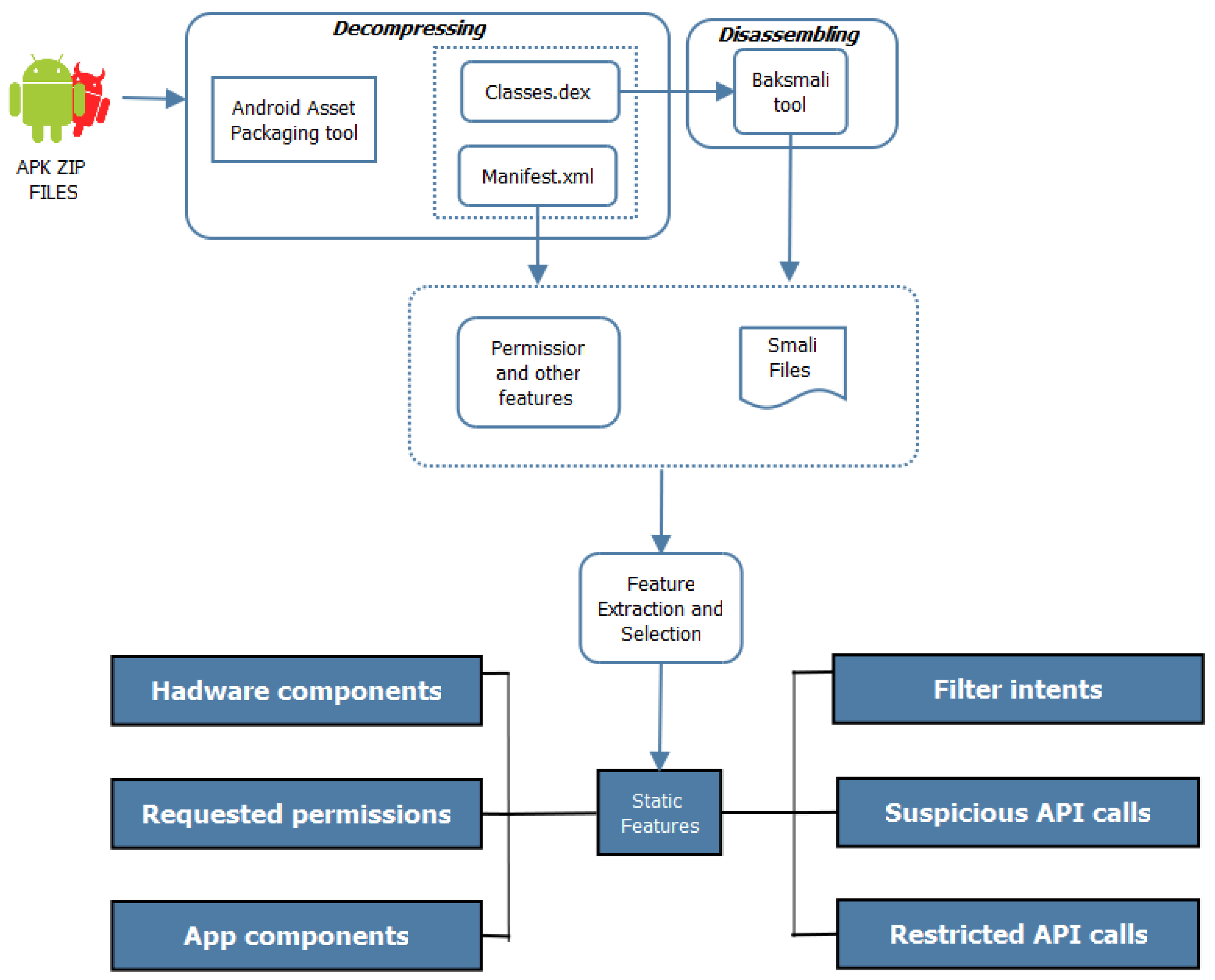
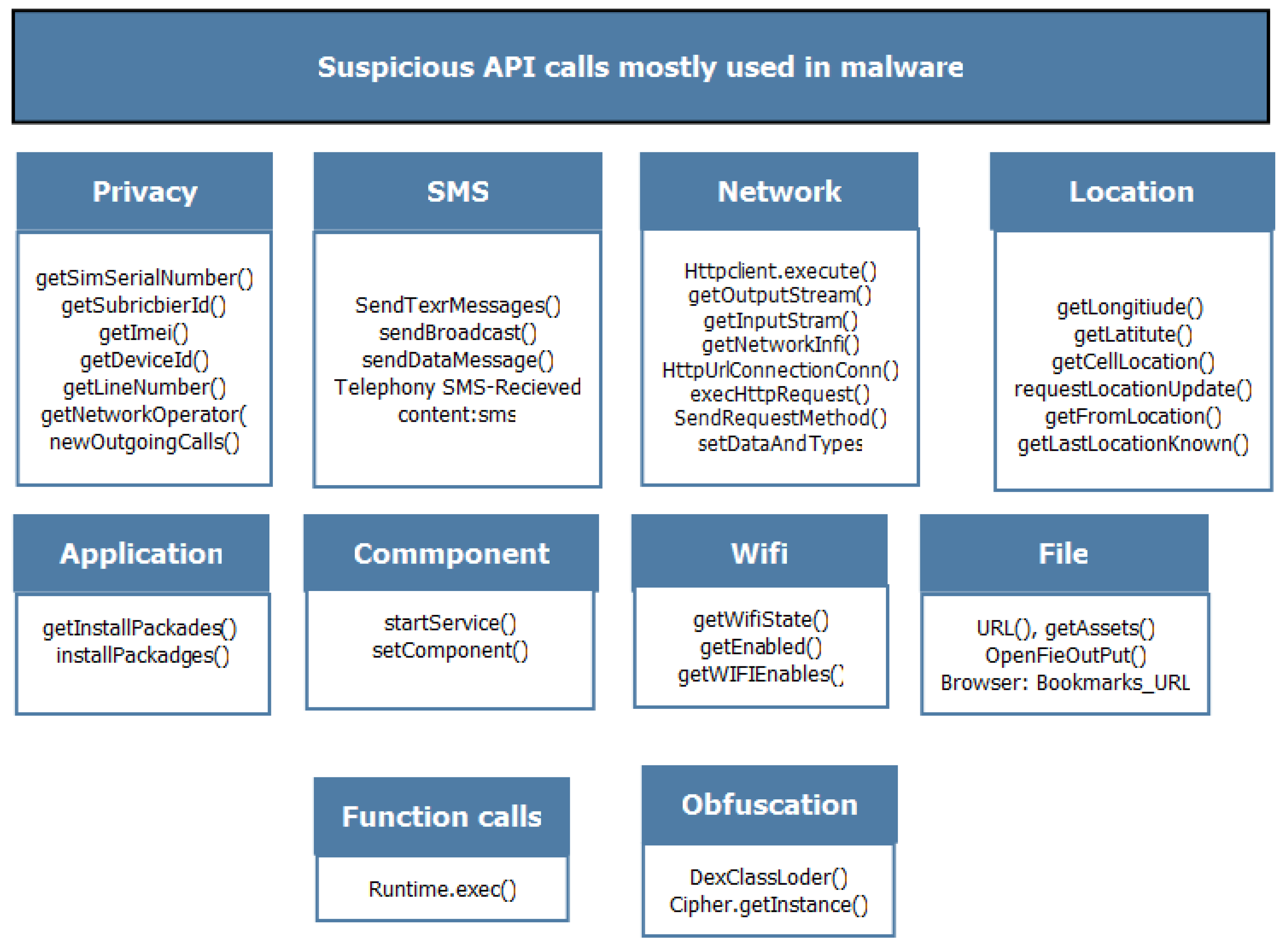
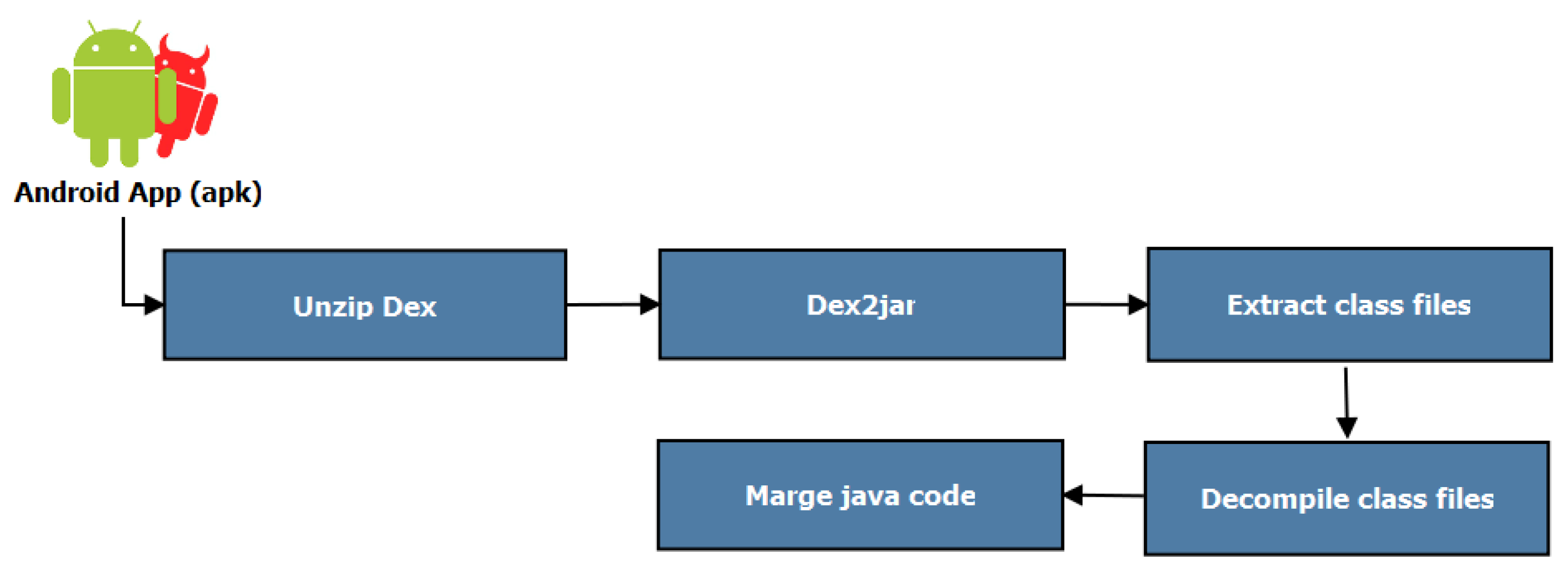

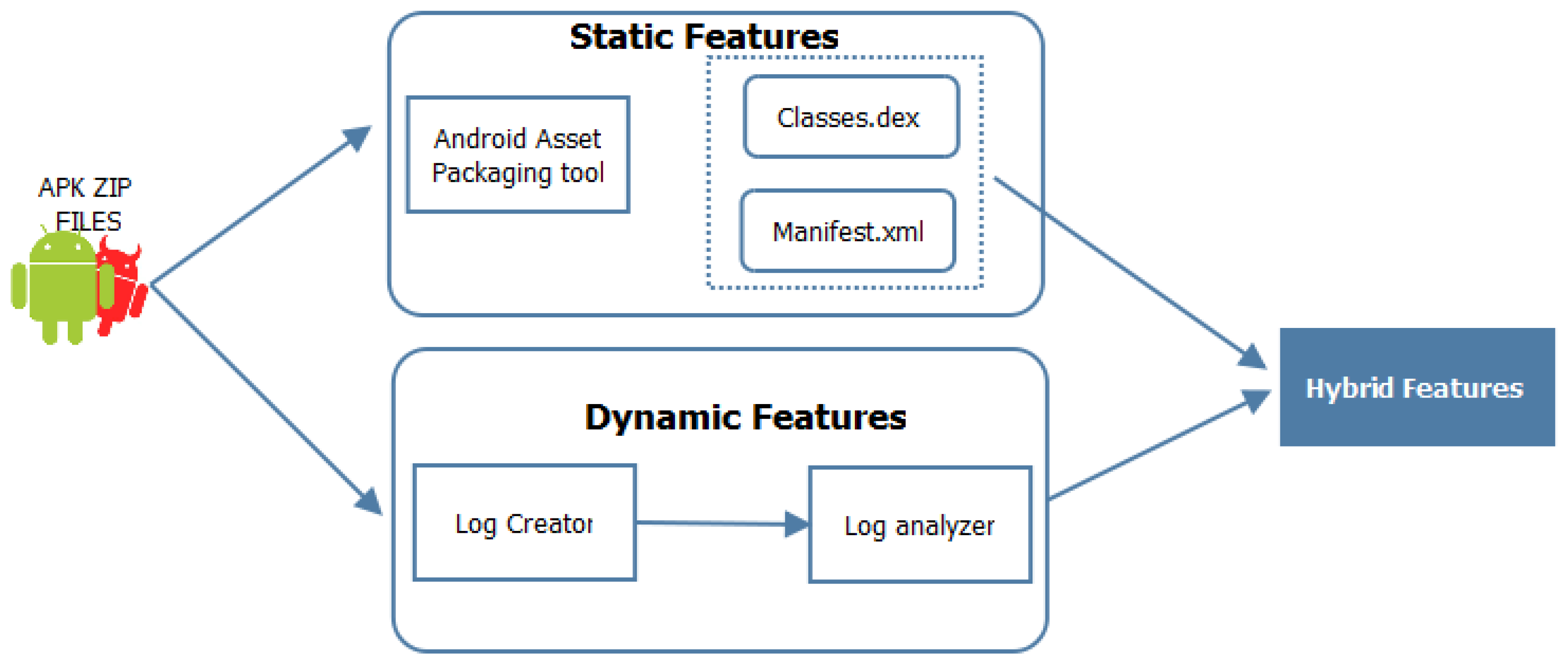
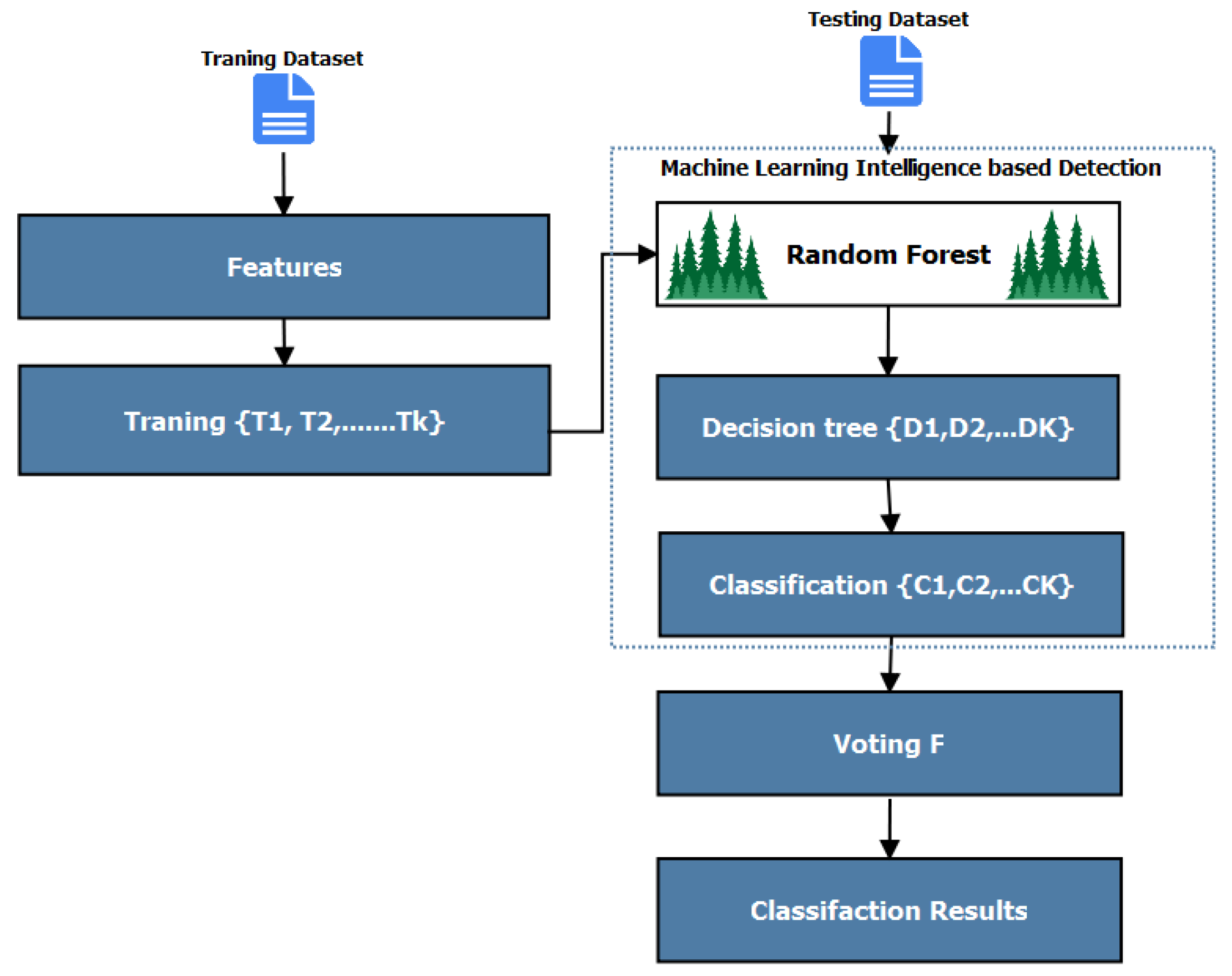
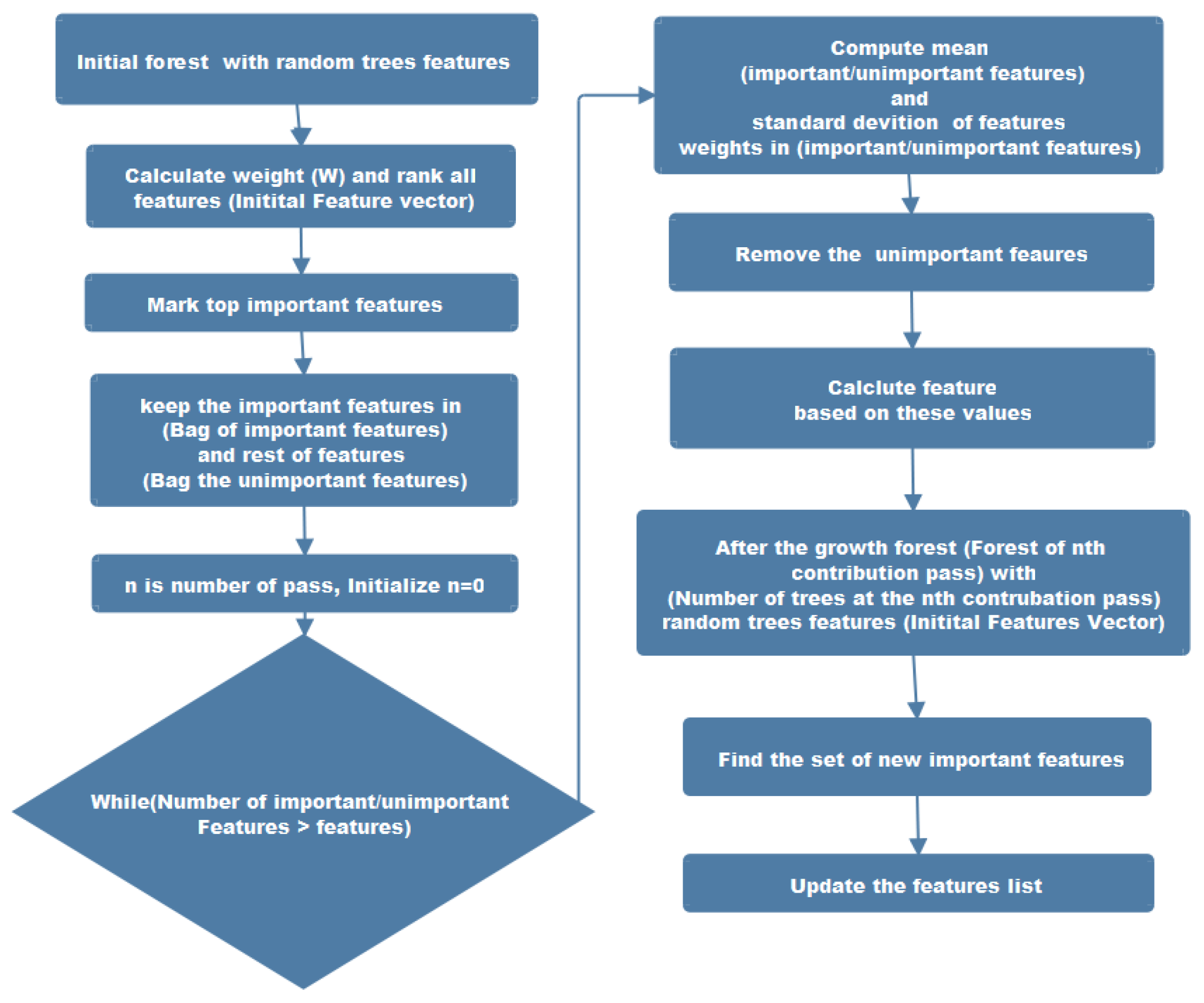
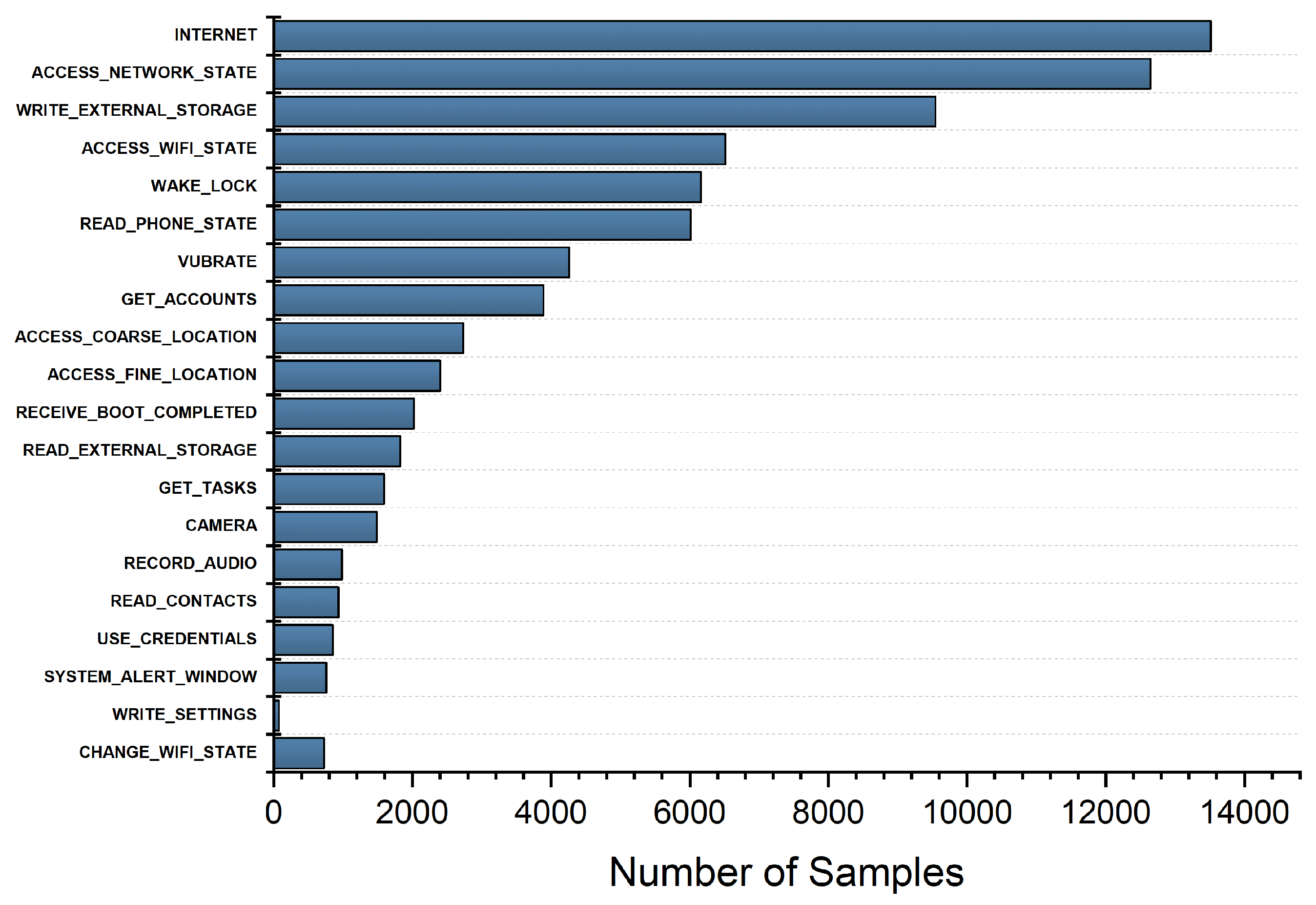
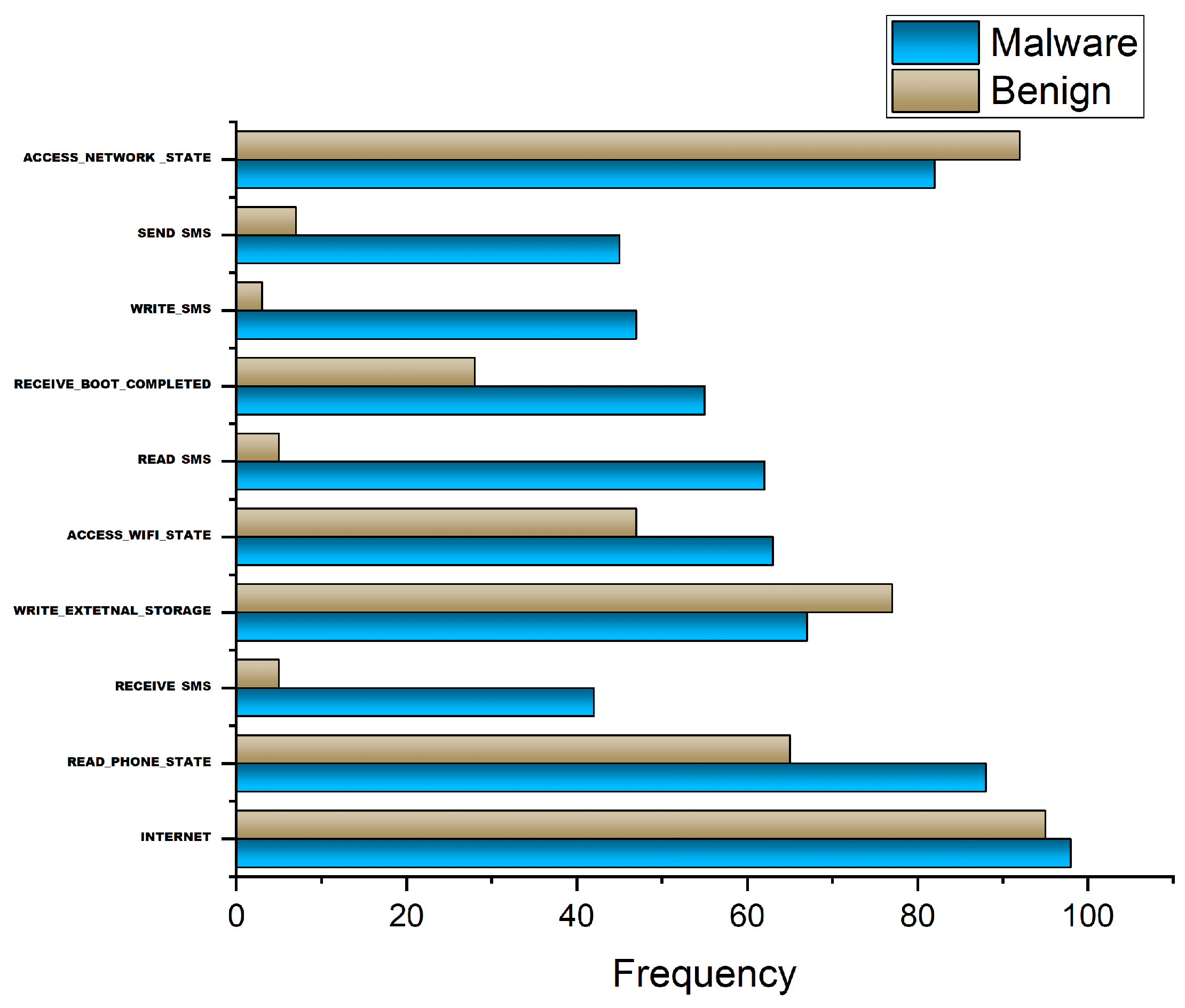
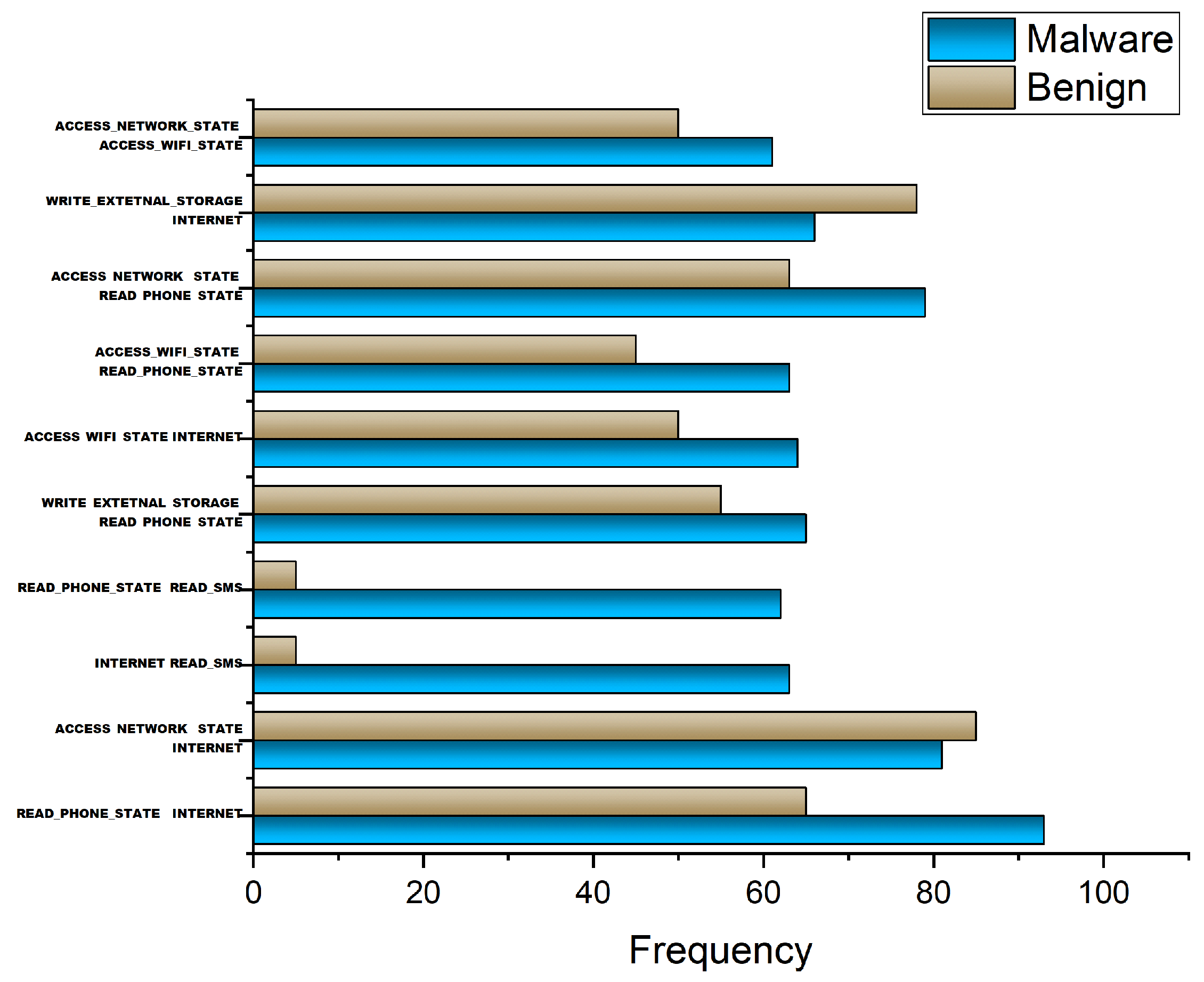
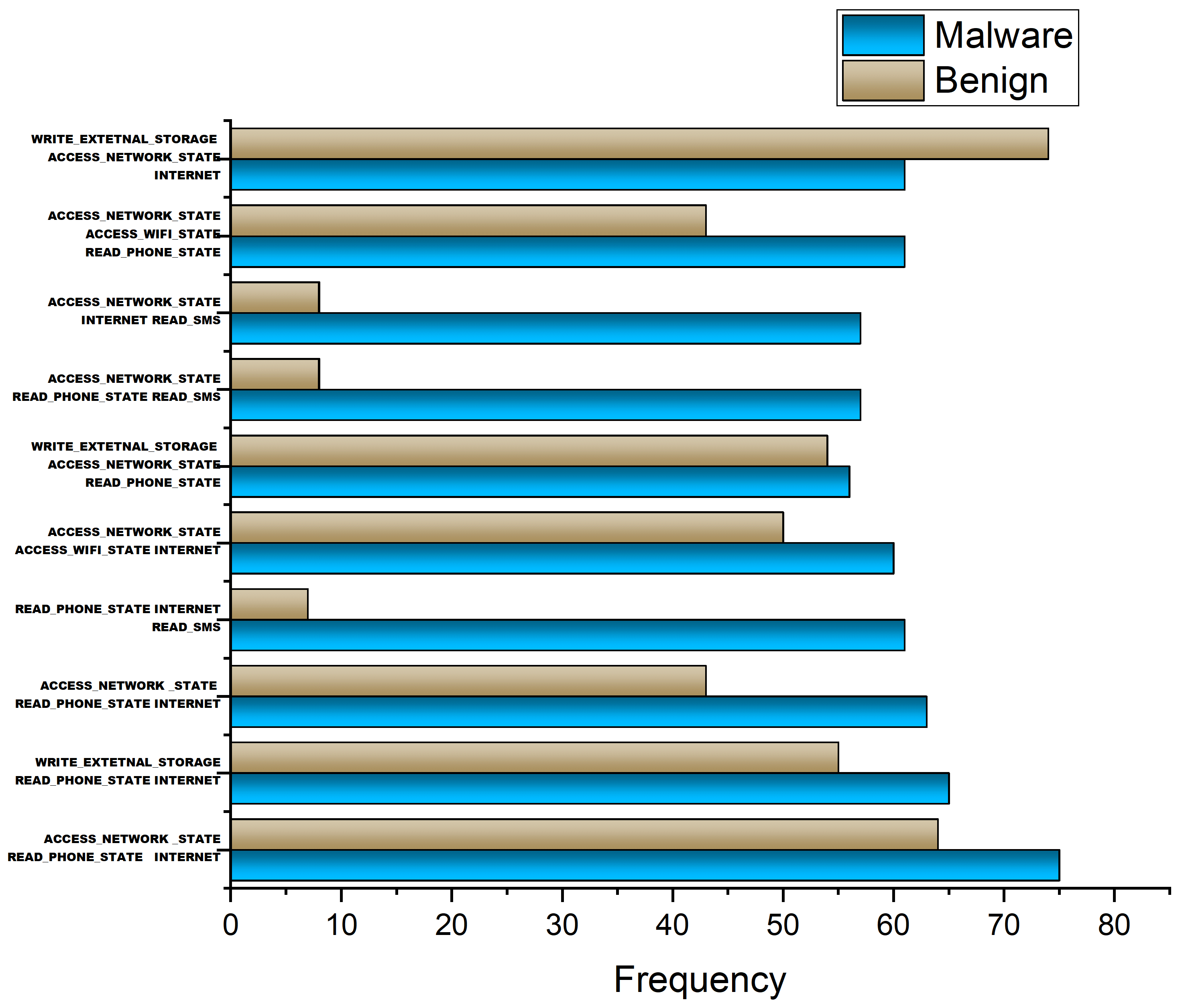
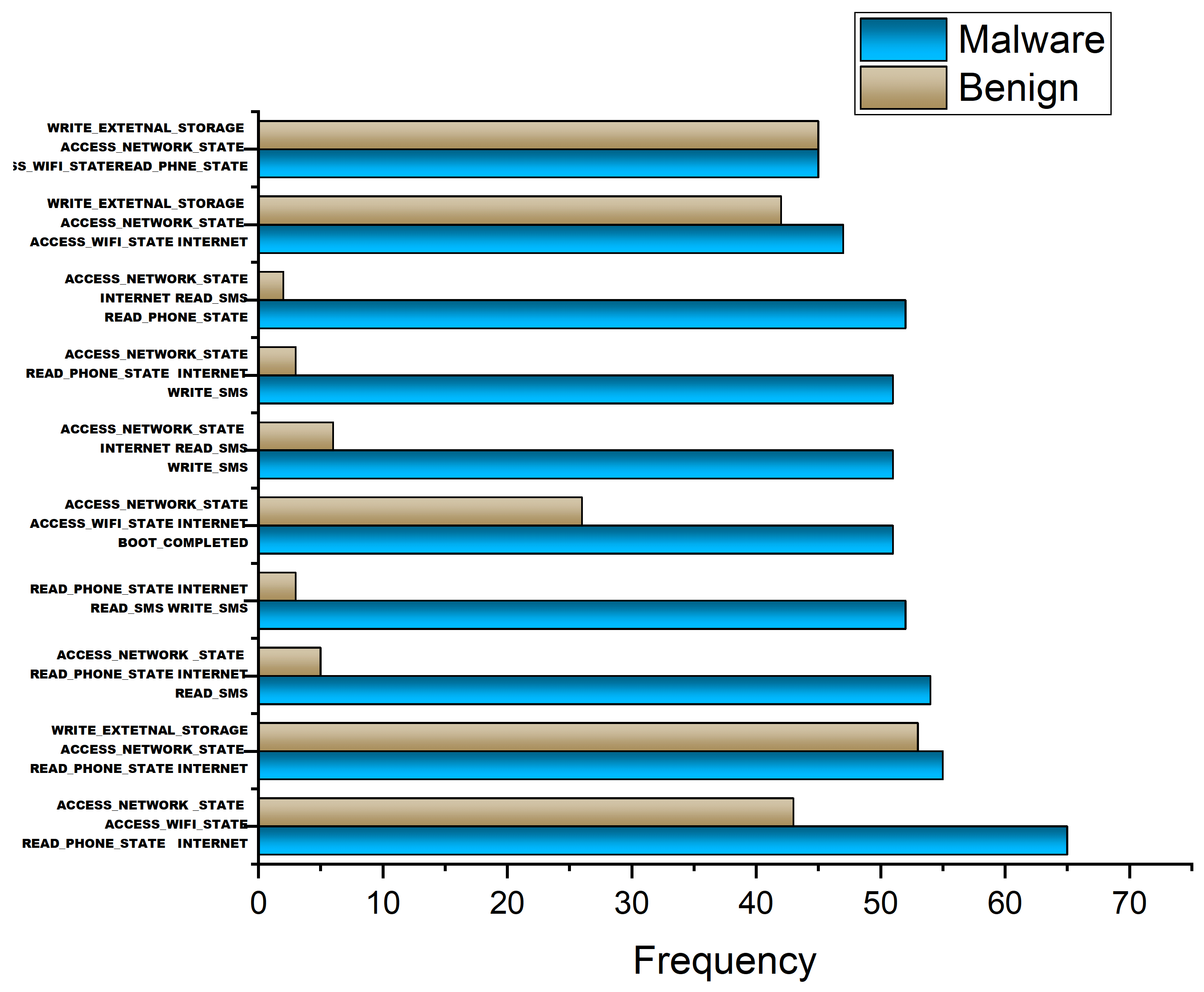
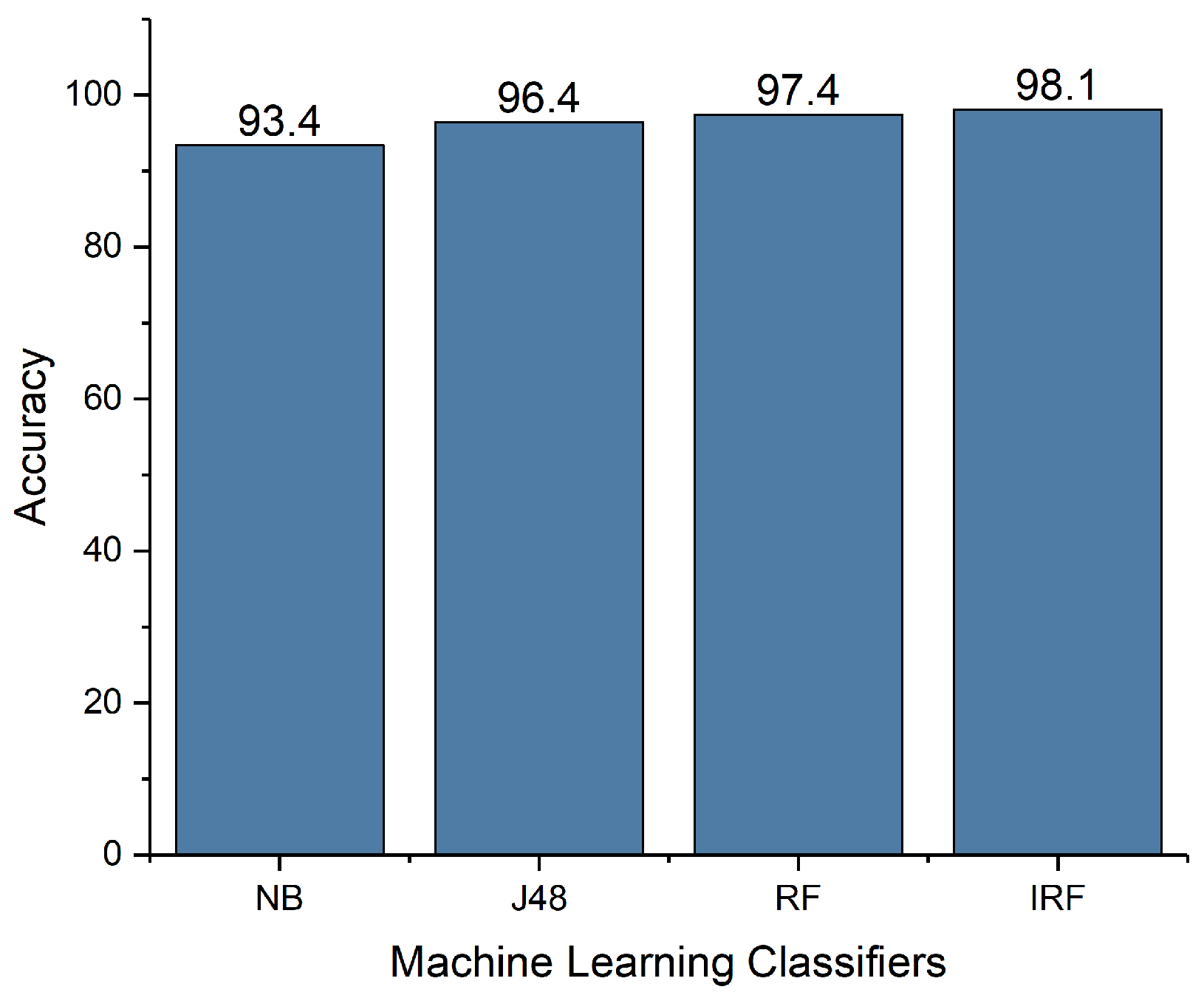
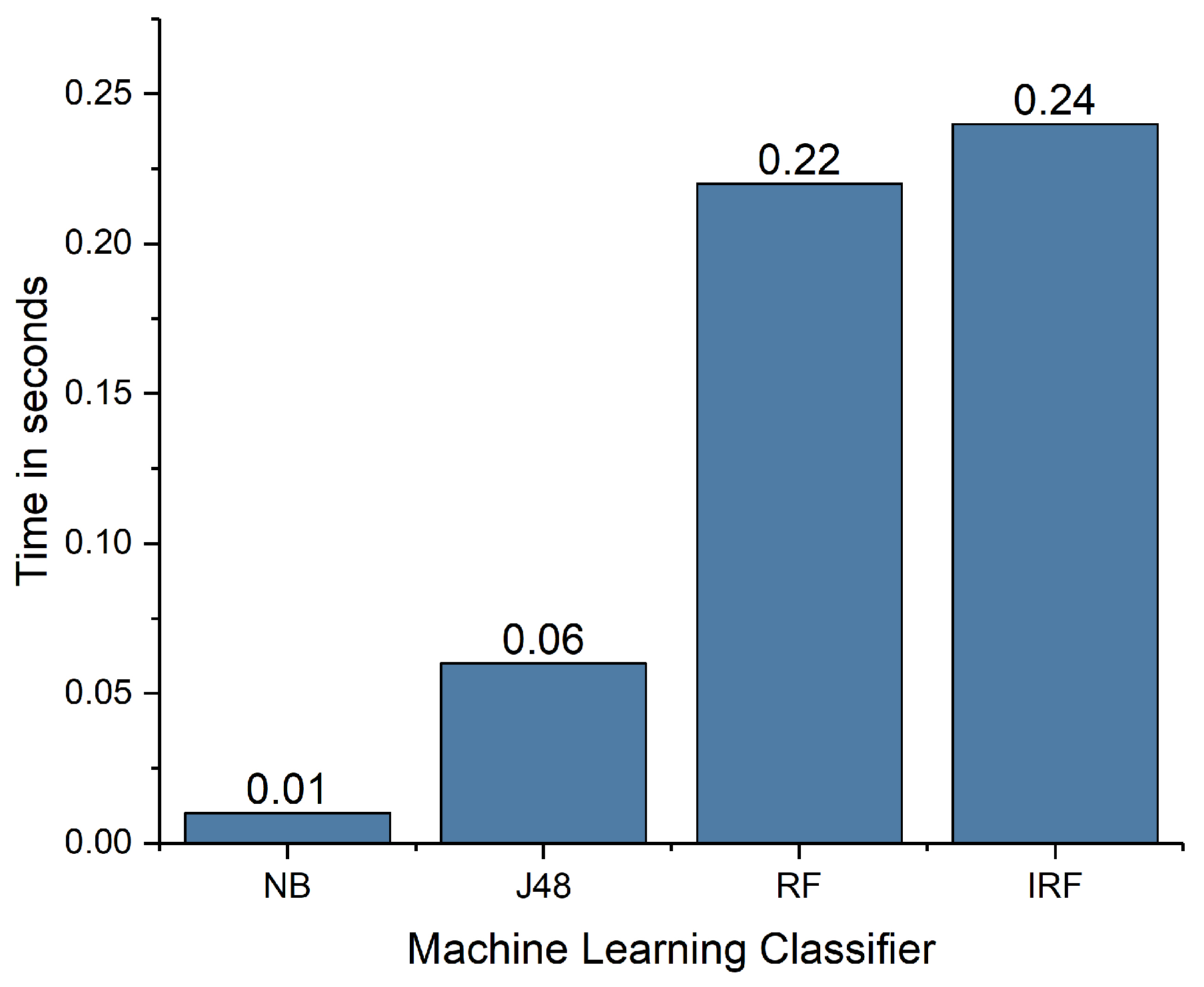
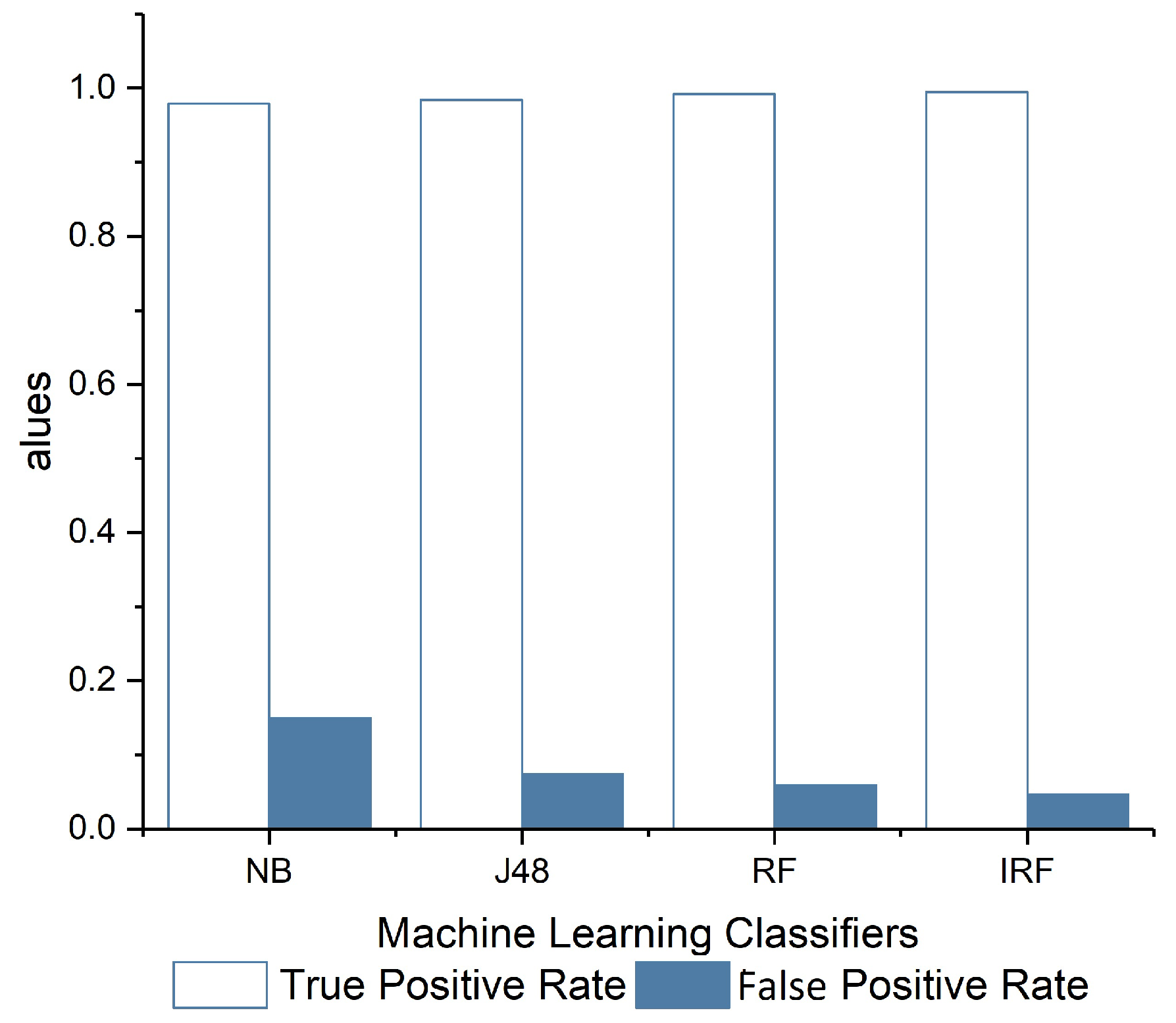
| Ref | Features | Accuracy | Machine Learning Models |
|---|---|---|---|
| [36] | Permission | 91.75% | Random Forest |
| [19] | Permission | 81% | C4.5, SVM |
| [37] | Permission | 88.2% | HMNB |
| [15] | Permission | - | AHP |
| [21] | Permission | 98.6 | J48 |
| [20] | Permission | 92.79% | Random Forest |
| [38] | Permission | 94.90% | Random Forest |
| [14] | Permission, API calls | 92.36% | Random Forest |
| [23] | Permission, API calls, intent | 97.87% | k-nearest neighbors |
| [39] | API call | 99% | k-nearest neighbors |
| [40] | API call | 93.04% | Signature matching |
| [41] | API call | 96.69% | SVM |
| [42] | ICC related features | 97.4% | SVM |
| [9] | Permission, command, API calls | 98.6% | Parallel classifier |
| Feature Sets | ||
|---|---|---|
| manifest | S1 | Hardware components |
| S2 | Requested permissions | |
| S3 | Application components | |
| S4 | Filtered intents | |
| dexcode | S5 | Restricted API calls |
| S6 | Used permission | |
| S7 | Suspicious API calls | |
| S8 | Network addresses | |
| Risky Permissions | |
|---|---|
| ACCESS_WIFI_STATE | SEND_SMS |
| READ_LOGS | READ_CALL_LOG |
| CAMERA | DISABLE_KEYGUARD |
| CHANGE_NETWORK_STATE | RESTART_PACKAGES |
| WRITE_APN_SETTINGS | SET_WALLPAPER |
| CHANGE_WIFI_STATE | INSTALL_PACKAGES |
| READ_CONTACTS | WRITE_CONTACTS |
| WRITE_SETTINGS | GET_TASKS |
| RECEIVE_MMS | ACCESS_WIFI_STATE |
| WRITE_APN_SETTINGS | SYSTEM_ALERT_WINDOW |
| READ_HISTORY_BOOKMARKS | RECEIVE_BOOT_COMPLETED |
| ACCESS_NETWORK_STATE | CALL_PHONE |
| READ_EXTERNAL_STORAGE | ACCESS_FINE_LOCATION |
| EXPAND_STATUS_BAR | ADD_SYSTEM_SERVICE |
| PERSISTENT_ACTIVITY | INTERNET |
| GET_ACCOUNTS | WRITE_SMS |
| PROCESS_OUTGOING_CALLS | CHANGE_CONFIGURATION |
| READ_HISTORY_BOOKMARKS | GET_PACKAGE_SIZE |
| WAKE_LOG | ACCESS_MOCK_LOCATION |
| WRITE_CALL_LOG | WRITE_HISTORY_BOOKMARKS |
| READ_PHONE_STATE | RECEIVE_WAP_PUSH |
| SET_ALARAM | WRITE_SMS |
| RECEIVE_SMS | READ_SMS |
| Ref | Features | Accuracy | Machine Learning Models |
|---|---|---|---|
| [46] | System call | 91.75% | Signature Matching |
| [12] | System call | 81% | K-Means |
| [47] | System call | 88.2% | Frequency |
| [48] | System call | - | Pattern matching |
| [35] | API call | 97.6 | KNN_M |
| [19] | Native Size | 99.9% | RF, SVM |
| Symbol | Definition |
|---|---|
| Initial feature vector | |
| Feature vector at the construction process | |
| Number of important features | |
| Number of unimportant features | |
| Forest at the construction process | |
| Number of tress | |
| Bag of important features | |
| Bag of unimportant features | |
| Weight of features j | |
| remove features until all the features have been eliminated | |
| new feature “mark as important” | |
| n | Classification accuracy |
| Permission Patterns | Benign | Malware |
|---|---|---|
| Common Android request permission | ||
| READ_PHONE_STATE, ACCESS_WIFI_STATE | 2.36 | 63.08 |
| INTERNET, ACCESS_WIFI_STATE | 5.05 | 63.49 |
| READ_PHONE_STATE | 31.87 | 93.4 |
| ACCESS_WIFI_STATE | 5.22 | 63.49 |
| ACCESS_NETWORK_STATE, ACCESS_WIFI_STATE | 3.99 | 60.31 |
| INTERNET, WRITE_EXTERNAL_STORAGE, READ_PHONE_STATE | 13.28 | 65.44 |
| INTERNET, READ_PHONE_STATE, ACCESS_NETWORK_STATE | 24.21 | 78.97 |
| INTERNET, READ_PHONE_STATE | 31.21 | 93.078 |
| WRITE_EXTERNAL_STORAGE, READ_PHONE_STATE | 13.37 | 65.53 |
| READ_PHONE_STATE, ACCESS_NETWORK_STATE | 24.21 | 79.05 |
| Common Android Run-time Permissions | ||
| READ_PHONE_STATE, ACCESS_NETWORK_STATE | 23.63 | 77.18 |
| INTERNET, READ_LOGS | 6.85 | 6.85 |
| READ_PHONE_STATE | 30.32 | 91.69 |
| INTERNET, READ_PHONE_STATE, ACCESS_NETWORK_STATE | 26.36 | 77.18 |
| READ_PHONE_STATE, VIBRATE | 21.92 | 65.28 |
| INTERNET, READ_PHONE_STATE | 29.9 | 91.52 |
| READ_PHONE_STATE, READ_LOGS | 5.38 | 46.86 |
| READ_LOGS | 6.93 | 47.6 |
| INTERNET, READ_PHONE_STATE, VIBRATE | 21.68 | 65.12 |
| Unique Android request permission | ||
| READ_PHONE_STATE, WRITE_SMS | 0 | 50.94 |
| INTERNET, READ_PHONE_STATE, ACCESS_WIFI_STATE | 0 | 63.09 |
| ACCESS_NETWORK_STATE, RECEIVE_BOOT_COMPLETED | 0 | 51.68 |
| ACCESS_NETWORK_STATE, WRITE_SMS | 0 | 49.64 |
| RECEIVE_BOOT_COMPLETED, ACCESS_WIFI_STATE | 0 | 42.63 |
| INTERNET, RECEIVE_BOOT_COMPLETED | 0 | 44.75 |
| WRITE_EXTERNAL_STORAGE, ACCESS_NETWORK_STATE, ACCESS_WIFI_STATE | 0 | 54.53 |
| READ_PHONE_STATE, RECEIVE_BOOT_COMPLETED | 0 | 43.12 |
| INTERNET, SEND_SMS | 0 | 43.12 |
| INTERNET, ACCESS_NETWORK_STATE, ACCESS_WIFI_STATE | 0 | 60.31 |
| Unique Android Runtime Permissions | ||
| INTERNET, READ_PHONE_STATE, ACCESS_NETWORK_STATE, VIBRATE | 0 | 55.42 |
| ACCESS_NETWORK_STATE, VIBRATE, READ_LOGS | 0 | 38.55 |
| READ_PHONE_STATE, ACCESS_NETWORK_STATE, READ_LOGS | 0 | 43.2 |
| READ_LOGS, INTERNET, ACCESS_NETWORK_STATE | 0 | 43.2 |
| READ_PHONE_STATE, VIBRATE, READ_LOGS | 0 | 41.33 |
| INTERNET, VIBRATE, READ_LOGS | 0 | 41.49 |
| READ_LOGS, INTERNET, READ_PHONE_STATE, | 0 | 46.87 |
| ACCESS_FINE_LOCATION, READ_PHONE_STATE, VIBRATE, INTERNET | 0 | 34.23 |
| INTERNET, SEND_SMS | 0 | 33.58 |
| INTERNET, ACCESS_FINE_LOCATION, READ_LOGS | 0 | 28.45 |
| Random Forest Based Malware Detection for Permissions | |
|---|---|
| ACCESS_WIFI_STATE | SEND_SMS |
| READ_LOGS | READ_CALL_LOG |
| RESTART_PACKAGES | DISABLE_KEYGUARD |
| READ_EXTERNAL_STORAGE | CHANGE_NETWORK_STATE |
| WRITE_APN_SETTINGS | SET_WALLPAPER |
| CHANGE_WIFI_STATE | INSTALL_PACKAGES |
| READ_CONTACTS | WRITE_CONTACTS |
| CAMERA | GET_TASKS |
| READ_HISTORY_BOOKMARKS | ACCESS_WIFI_STATE |
| WRITE_APN_SETTINGS | SYSTEM_ALERT_WINDOW |
| WRITE_SETTINGS | RECEIVE_BOOT_COMPLETED |
| Alogrthim | TP | FP | TN | FN | TPR | FPR | ACC |
|---|---|---|---|---|---|---|---|
| NB | 1233 | 101 | 573 | 27 | 0.979 | 0.150 | 0.934 |
| J48 | 1240 | 50 | 624 | 20 | 0.984 | 0.074 | 0.964 |
| RF | 1250 | 40 | 634 | 10 | 0.992 | 0.059 | 0.974 |
| IRF | 1254 | 31 | 643 | 6 | 0.995 | 0.046 | 0.981 |
© 2019 by the authors. Licensee MDPI, Basel, Switzerland. This article is an open access article distributed under the terms and conditions of the Creative Commons Attribution (CC BY) license (http://creativecommons.org/licenses/by/4.0/).
Share and Cite
Kumar, R.; Zhang, X.; Khan, R.U.; Sharif, A. Research on Data Mining of Permission-Induced Risk for Android IoT Devices. Appl. Sci. 2019, 9, 277. https://doi.org/10.3390/app9020277
Kumar R, Zhang X, Khan RU, Sharif A. Research on Data Mining of Permission-Induced Risk for Android IoT Devices. Applied Sciences. 2019; 9(2):277. https://doi.org/10.3390/app9020277
Chicago/Turabian StyleKumar, Rajesh, Xiaosong Zhang, Riaz Ullah Khan, and Abubakar Sharif. 2019. "Research on Data Mining of Permission-Induced Risk for Android IoT Devices" Applied Sciences 9, no. 2: 277. https://doi.org/10.3390/app9020277
APA StyleKumar, R., Zhang, X., Khan, R. U., & Sharif, A. (2019). Research on Data Mining of Permission-Induced Risk for Android IoT Devices. Applied Sciences, 9(2), 277. https://doi.org/10.3390/app9020277





